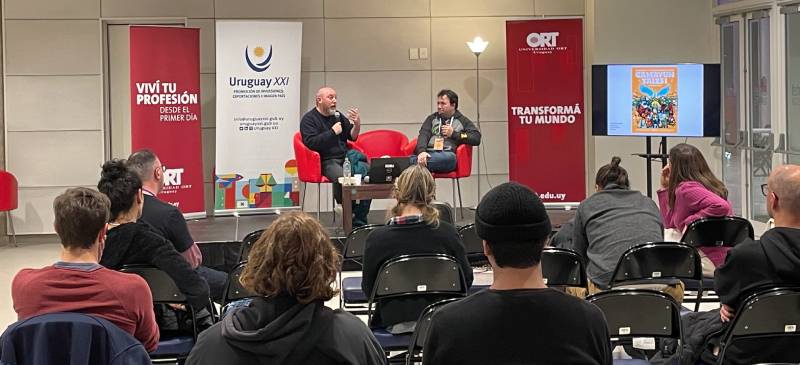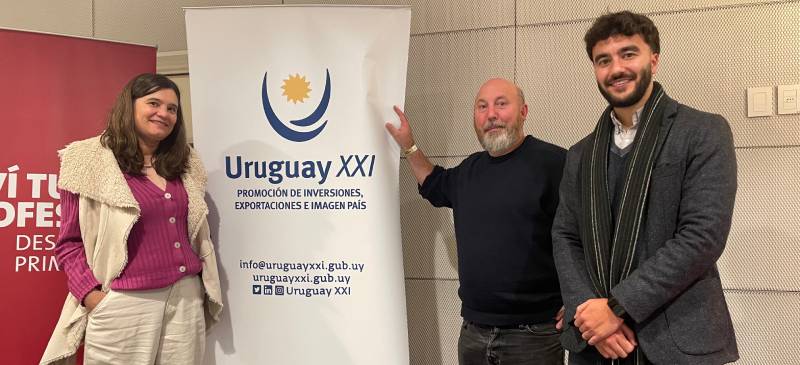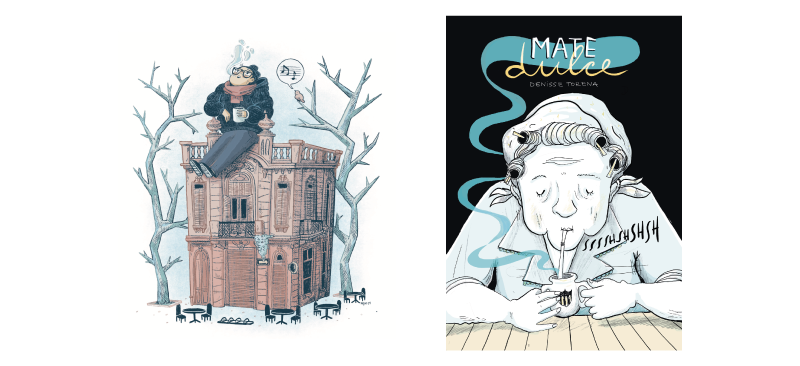- Home
- About us
- News
- Events
- EXPORT Export
- BUY Buy
- INVEST Invest
- COUNTRY BRAND Country Brand
-
INFORMATION CENTER
Information center
InformationCenterInformationCenterReports Country reports Department reports Foreign trade reports Product-Destination worksheet Sectors reports Work documentsStatistical information Classification Uruguay XXI Exports Imports Innovative National Effort Macroeconomic Monitor Tools Buyers Exporters Investors
- Contact
-
Languages
French talent scout Nicolas Grivel chooses three comic book illustrators from Uruguay.
Invited by Uruguay XXI, Grivel gave a lecture at Montevideo Comics and pointed out that it is “very unusual” to find so much talent in just one country.
Share:

French literary agent Nicolas Grivel, who specializes in the management and development of international graphic novel and animation projects and has worked as a senior editor for Pika Édition and as a consultant for the U.S. studio Laika Animation Studios, travels the world to meet new artists. “What I like most is to introduce new voices. My job is to bring the right project to the right person,” he explained while visiting Uruguay.
Invited by the investment and export promotion agency Uruguay XXI, Grivel participated in the Montevideo Comics festival with a lecture in which he shared guidelines for internationalizing an illustration or comic book project. He then received and evaluated the portfolios of more than 14 Uruguayan artists who came to his meeting to reach foreign markets with their projects.
As a result, he chose three artists to represent. “I travel to various parts of the world to see portfolios (after Uruguay, he will visit London, Georgia, New Zealand, and Rome), and sometimes I don’t find any. In this case, it happened exceptionally; it is very unusual to have found so many good ones. Sometimes just one is enough, it’s like going fishing, but here we chose three good artists of very high quality, and I know walking with them will be very productive,” he said.
The next step for the illustrators will be to sign a representation agreement, then work on the presentation of each of the projects, and finally make a pitch to a publishing company, which could be European or North American.
The agent estimates that the process will take six months.

Uruguayan DNA
“I like it when an artist uses the background of their place of upbringing, that they artistically use Uruguayan culture and that they don’t adapt it to look like something Japanese or North American, for example, that they use Uruguay’s DNA,” he said when asked about the characteristics of the works he selected.
Denisse Torena was one of the artists who caught Grivel’s attention with a graphic novel that takes place in the cities of Nueva Palmira, Conchillas, and Carmelo, in the department of Colonia, and that goes through the family stories that a grandmother tells her granddaughter. “It is fictionalized but based on real events,” explained the artist. Torena’s style in this project is a clear line in an accessible and expressive format. Grivel made some suggestions to her, and the author is now working on them.
“It is an Uruguayan project with a universal theme, nostalgia. That’s what I’m looking for, and that was, in general, what I saw in all the works, people who want to tell where they come from,” Grivel recounted.
The talent scout was also moved by the project of Verónica Alvarado, a Venezuelan living in Uruguay for five years.
Her first graphic novel, which is still in full genesis, deals with the issue of migration and her adaptation from her native Caracas to Montevideo. “What I have now is a conceptual sketch,” the artist indicated while expressing that it is a “very autobiographical” work that illustrates events as a Venezuelan immigrant in Uruguay. “I found in Grivel someone who understands what I want to say. I expect that the book will happen,” she added. Finally, illustrator and character designer Alfonso Rosso - with more than ten years of experience working for different areas of trade-in publishing, animation, advertising, children’s books, toy design, and mobile games - caught Grivel’s attention.
“All the work I saw had different styles. I saw much versatility. Everyone went their way,” the Frenchman reflected on the portfolios analyzed.
“When I was in China, doing the same work, there was a repetition of styles. They were different people drawing the same thing. In Uruguay, I saw much talent that would be very well received in the Belgian-French market because there is a strong cultural connection. They don’t need to know French; they must write in their own language. We are at the perfect moment for Uruguayan artists to enter this market,” he analyzed.
“Comic books are a universal language, and even if I am not a polyglot, I can see at first glance the essence of the work and know if it has a future.
Translators are incredible partners, but their work is after the complete production; the important thing is if the story is coherent, sincere, heartfelt, incarnated and seduces the reader, then it already has international reach before being translated,” he said. In Uruguay, Grivel found several themes that could be developed into graphic novels, such as cattle breeding, Colonia del Sacramento, soccer, or the Andes survivors.

Six keys to a project with international potential
“A portfolio has to be like a garden and should be a showcase where the draftsman exhibits his versatility and diversity, oriented to the client’s needs,” Grivel told Uruguay XXI.
The expert developed six critical points about the keys to having an attractive project for international markets:
- Create a cover and description of the project in five or six sentences. “Editors don’t have time for more,” Grivel explained. This first step, in the expert’s opinion, the most decisive, is the basis and should be aimed at convincing the editors’ table of the project’s strength. Secondly, the author must also convince the editors that they are capable and prepared to see the project through. In this sense, it is essential to anticipate the length of the project and not leave it as a question mark.
- Present an excerpt or fragment of the book of between 5 and 10 pages. This would be the equivalent of a movie trailer, in which the idea of the project is given in a few pages, which should be of the same quality as the final project.” If a page is not up to the same standard, it is extracted and worked on until it is improved,” Grivel said.
- Create a “library” of characters with their description and information.
- Show in a personal way why the author chose this project and explain their motivations.
- Submit a curriculum vitae with a short biography, studies, and past publications.
- Make an appendix that includes photos and documents that give a record of the reality of the author’s country and help the editors contextualize the project’s historical moment.
